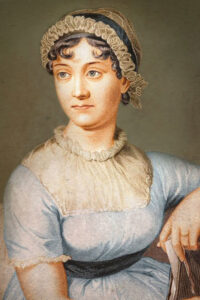
Persuasion
It is a truth universally acknowledged, that a single man in possession of a good fortune, must be in want of a wife.
However little known the feelings or views of such a man may be on his first entering a neighborhood, this truth is so well fixed in the minds of the surrounding families, that he is considered the rightful property of someone or other of their daughters.
“My dear Mr. Bennet,” said his lady to him one day, “have you heard that Netherfield Park is let at last?”
Mr. Bennet replied that he had not.
“But it is,” returned she; “for Mrs. Long has just been here, and she told me all about it.”
Mr. Bennet made no answer.
“Do you not want to know who has taken it?” cried his wife impatiently.
“You want to tell me, and I have no objection to hearing it.”
This was invitation enough.
“Why, my dear, you must know, Mrs. Long says that Netherfield is taken by a young man of large fortune from the north of England; that he came down on Monday in a chaise and four to see the place, and was so much delighted with it, that he agreed with Mr. Morris immediately; that he is to take possession before Michaelmas, and some of his servants are to be in the house by the end of next week.”
Read or download Book
Jane Austen
Jane Austen (16 December 1775 – 18 July 1817) was an English novelist known primarily for her six novels, which implicitly interpret, critique, and comment upon the British landed gentry at the end of the 18th century. Austen’s plots often explore the dependence of women on marriage for the pursuit of favorable social standing and economic security. Her works are an implicit critique of the novels of sensibility of the second half of the 18th century and are part of the transition to 19th-century literary realism. Her deft use of social commentary, realism, and biting irony have earned her acclaim among critics and scholars.
The anonymously published Sense and Sensibility (1811), Pride and Prejudice (1813), Mansfield Park (1814), and Emma (1816), were a modest success but brought her little fame in her lifetime. She wrote two other novels—Northanger Abbey and Persuasion, both published posthumously in 1817—and began another, eventually titled Sanditon, but died before its completion. She also left behind three volumes of juvenile writings in manuscript, the short epistolary novel Lady Susan, and the unfinished novel The Watsons.
Since her death, Austen’s novels have rarely been out of print. A significant transition in her reputation occurred in 1833 when they were republished in Richard Bentley’s Standard Novels series (illustrated by Ferdinand Pickering and sold as a set). They gradually gained wide acclaim and popular readership. In 1869, fifty-two years after her death, her nephew’s publication of A Memoir of Jane Austen introduced a compelling version of her writing career and supposedly uneventful life to an eager audience. Her work has inspired a large number of critical essays and has been included in many literary anthologies. Her novels have also inspired many films, including 1940’s Pride and Prejudice, 1995’s Sense and Sensibility, and 2016’s Love & Friendship.
Published author
Like many women authors at the time, Austen published her books anonymously. At the time, the ideal roles for a woman were as wife and mother, and writing for women was regarded at best as a secondary form of activity; a woman who wished to be a full-time writer was felt to be degrading her femininity, so books by women were usually published anonymously to maintain the conceit that the female writer was only publishing as a sort of part-time job, and was not seeking to become a “literary lioness”.
During her time at Chawton, Austen published four generally well-received novels. Through her brother Henry, the publisher Thomas Egerton agreed to publish Sense and Sensibility, which, like all of Austen’s novels except Pride and Prejudice, was published “on commission”, that is, at the author’s financial risk. When publishing on commission, publishers would advance the costs of publication, repay themselves as books were sold, and then charge a 10% commission for each book sold, paying the rest to the author. If a novel did not recover its costs through sales, the author was responsible for them. The alternative to selling via commission was by selling the copyright, where an author received a one-time payment from the publisher for the manuscript, which occurred with Pride and Prejudice. Austen’s experience with Susan (the manuscript that became Northanger Abbey) where she sold the copyright to the publisher Crosby & Sons for £10, who did not publish the book, forcing her to buy back the copyright to get her work published, left Austen leery of this method of publishing. The final alternative, selling by subscription, where a group of people would agree to buy a book in advance, was not an option for Austen as only authors who were well known or had an influential aristocratic patron who would recommend an upcoming book to their friends, could sell by subscription.[104] Sense and Sensibility appeared in October 1811, and was described as being written: “By a Lady”. As it was sold on commission, Egerton used expensive paper and set the price at 15 shillings (equivalent to £58 in 2021)
Early manuscripts (1796–1798)
After finishing Lady Susan, Austen began her first full-length novel, Elinor and Marianne. Her sister remembered that it was read to the family “before 1796” and was told through a series of letters. Without surviving original manuscripts, there is no way to know how much of the original draft survived in the novel published anonymously in 1811 as Sense and Sensibility.
Austen began a second novel, First Impressions (later published as Pride and Prejudice), in 1796. She completed the initial draft in August 1797, aged 21; as with all of her novels, Austen read the work aloud to her family as she was working on it and it became an “established favorite”. At this time, her father made the first attempt to publish one of her novels. In November 1797, George Austen wrote to Thomas Cadell, an established publisher in London, to ask if he would consider publishing First Impressions. Cadell returned Mr. Austen’s letter, marking it “Declined by Return of Post”. Austen may not have known of her father’s efforts. Following the completion of First Impressions, Austen returned to Elinor and Marianne and from November 1797 until mid-1798, revised it heavily; she eliminated the epistolary format in favor of third-person narration and produced something close to Sense and Sensibility. In 1797, Austen met her cousin (and future sister-in-law), Eliza de Feuillide, a French aristocrat whose first husband the Comte de Feuillide had been guillotined, causing her to flee to Britain, where she married Henry Austen. The description of the execution of the Comte de Feuillide related to his widow left Austen with an intense horror of the French Revolution that lasted for the rest of her life.
During the middle of 1798, after finishing revisions of Elinor and Marianne, Austen began writing a third novel with the working title Susan—later Northanger Abbey—a satire on the popular Gothic novel. Austen completed her work about a year later. In early 1803, Henry Austen offered Susan to Benjamin Crosby, a London publisher, who paid £10 for the copyright. Crosby promised early publication and went so far as to advertise the book publicly as being “in the press”, but did nothing more. The manuscript remained in Crosby’s hands, unpublished, until Austen repurchased the copyright from him in 1816.






